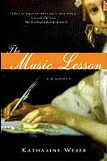E X C E R P T
“Forty-one, Patricia. I can’t believe it at all. Look at you. You’ve been sealed up in some kind of cryogenic storage. In West Cork, the women have no teeth of their own by forty-one, they have chin whiskers, their dugs are down to their waists, they’ve dried up completely,” he said. “When I thought to look up me fancy New York cousin, I never thought I’d be gattlin’ after you. I thought you’d remind me of me mam, or me granny, or Sister Margaret from school. She was a terror, that one.”
These remarks, uttered on our third or fourth night together, might have offended me had they not been murmured by Mickey as he lay sprawled in my bed, idly tracing a line down my bare hip with one intoxicating fingertip.
I had been in cold storage, until Mickey. How can I explain what it is about him? How can I describe the attraction in words? It feels so primitive at times that I am almost afraid of it–it, my desire for him, my obsession. Mickey has changed me. Everything has been rearranged.
Years ago I saw a television documentary about heart transplants that fascinated me. The donor heart, which has been kept on ice, is warmed up and placed inside the chest where the diseased heart had been moments before. After hours of surgery, the moment of truth comes when the clamps are removed and blood flows into this new heart, which has been chilled and still for several hours. Warmed by the circulating blood, the heart slowly begins to do what a heart is meant to do–it starts to beat again.
Now with the deepest evening darkness of late December pressing against the windows, we lay twined together like satiated kittens.
I eyed him and put my head back down on the bony indentation below his sternum.
“What do you mean, pick one out? One what? A painting?” I listened to the quiet steady thump of his heart. “There’s one over there,” I said languidly, pointing to the framed poster from the Matisse in Morocco show that hangs on my bedroom wall. “It’s very blue that painting. Very Moroccan. Very Matisse.” I wasn’t really paying attention yet.
“What I mean is, on a purely theoretical basis, If I showed you a group of paintings, would you automatically know which one was best?”
“Oh Mickey, of course, sure. You bet. The Patricia Dolan prize for excellence is awarded to…this one.” I reached up and pressed my fingertips to his philtrum, which is perfectly formed, like that of a Raphael angel. His lips parted a little, and I slid my index finger down and slipped it between them. We were like children, always touching, always playing. He welcomed my finger with a brief touch from the tip of his tongue, just for an instant, but then he pushed my hand and turned his head away, suddenly serious.
“Do you think,” he asked in a measured voice, very slowly and deliberately, keeping all of his consonants rounded up instead of letting them blur at the edges, “very seriously, Patricia, given your expertise in Dutch paintings of the seventeenth century, that you could pick out the best Vermeer from a group of paintings that are all by Vermeer?”
Sometimes I study her for so long that I need to get away from that room, and I go for a walk along the cow path that passes by the cottage and goes around the hem of the cove and up the opposite side. At the edge of a field where the cow path doubles back, I like to climb through a barbed-wire fence that’s there to keep cows in, not the likes of me out, and then I walk across a series of crooked ancient fields toward the sea, all the way to the rock at the top of the cliff–I’m not sure which–is called Ardnageeha, which means “height of the wind.”
The Dutch painters of the seventeenth century were not afraid of the wind. Think of those skies filling the canvas; think of those towering dark clouds, those windlashed trees. At Ardnageeha, I imagine Jacob van Ruisdael beside me, working with his characteristic probity, painting the winds portrait.
Copyright © 1998 by Katharine Weber. All rights reserved.
